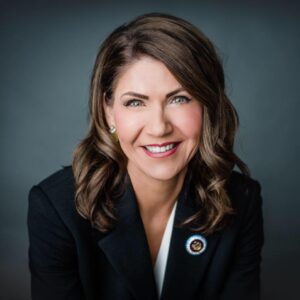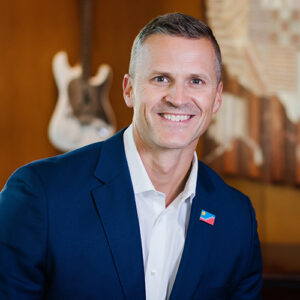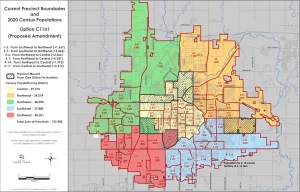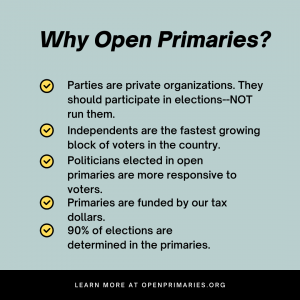Sioux Falls and South Dakota have a big election coming up, and I don’t mean the 2024 presidential election. In 2026 we will elect new city and state leaders. While that will undoubtedly be entertaining, it may not actually change much. But before then we have opportunities to make some structural and procedural changes that would truly improve our local governments in 2026.
We Will Have a New Governor and Maybe a New Election System in South Dakota

Governor Noem is term limited in 2026
In South Dakota, Governor Noem will likely be ending her eight-year term (unless she vacates the position earlier) and we will have a US Senate election, a US House election and more. But perhaps most importantly, our statewide elections might be run in a more open and democratic manner than any in history.
South Dakota could be conducting its first open primary in 2026, if the initiative I am involved with is successful. South Dakota would be a better place if all voters had the opportunity to fully participate in the election process. Our elections would be more fair and competitive. We hope voters will be deciding that question in 2024. Fingers crossed.
Sioux Falls Will Elect a New Mayor

Mayor TenHaken is term limited in 2026
In Sioux Falls, Mayor TenHaken will be ending his eight-year term as our fourth mayor under the strong mayor form of government. Some council spots will be open as well.
The 2026 mayoral election promises to have a crowded field. That always happens in our city when a mayor’s second term is expiring. In his first race, Mayor Munson won a seven-person contest. Mayor Huether and Mayor TenHaken both won races with six candidates the first time they ran.
While it is encouraging to see so much serious interest in leading our city, there is a downside. Our current plurality election system doesn’t always work well when there are so many candidates.
Our Election System Doesn’t Work Well
Our plurality election system can produce surprises and thwart voter intent. One need look no further than the 1992 presidential election for a good example. Because of what is called the “spoiler effect” George Bush lost his 1992 reelection when Ross Perot entered the race and took some of his supporters. Bill Clinton snuck in the back door with only 43% of the popular vote. It’s not a big stretch to suggest that most voters didn’t get what they wanted, someone to the right of Bill Clinton.
We have had similar situations in our city elections when there are three or more candidates for a single office. I encourage the city council to improve how we vote for city officials. Happily, there is an easy fix available.
Approval Voting Would Improve Sioux Falls Elections
Fargo has demonstrated that approval voting is a good way to give voters a chance to express their preferences more fully. And most importantly, it eliminates both the spoiler effect and the need for expensive runoff elections.
Ranked choice voting is another great alternative, although that would require legislative permission before we could adopt it. Given that, I recommend approval voting.
New Job Description for Mayor
I have some suggestions for improving the structure of our city government in advance of the 2026 election. My main recommendation is that the Charter Revision Commission give voters the opportunity to improve the mayor’s job description before the new person gets the job. A more traditional separation of powers in city government could help avoid some of the problems the city has experienced. The mayor would no longer serve on the city council.
The city’s chief executive job is more than enough for one person. I envision a structure like that used in state and federal government where the chief executive is separate from the legislature. This change would empower the council to take a stronger role in setting policy, as we originally intended thirty years ago when we put this form of city government in place.
Create Another City Council District
Perhaps the Charter Revision Commission will give voters the opportunity to add a sixth council district at the same time to keep the number of council members at nine. Some residents feel the growth of our city since 1995 more than justifies adding another district.

Is it time for a sixth council district in Sioux Falls?
So, here’s two scenarios for how the 2026 election could go in our city and state. One assumes no change, while the other assumes we fix some obvious problems with our voting systems and city structure.
Politics as Usual in 2026
With no change to election laws or the city charter, the Sioux Falls city election in April would attract many candidates, especially for mayor. There would be an expensive runoff three weeks later for the top two candidates, and perhaps in some of the city council races as well. Candidates would scramble to raise money for a second campaign.
The new mayor would take office in May and, like his predecessors, struggle for months trying to deal with the heavy workload of running the city and the city council. The council will continue to coast, generally following the lead of the mayor.
In June, half of South Dakota voters would participate in the Republican primary election, the only election that really matters in the state. The other half would, in effect, once again be spectators. Candidates that advance would likely prevail in November.

The November general election is the only time all South Dakota voters get an equal chance to vote, but by then most of the races have been decided. We would once again end up with a bunch of elected officials whose political philosophies are right of the general public’s.
But that doesn’t have to happen. We can do better. Here’s a more intriguing scenario.
A Better Alternative for 2026
Our local and state governments could be very different if our open primaries initiative passes, the Charter Revision Commission changes the city charter and the city council adopts approval voting. The 2026 election would then be much more interesting and democratic. Voters would be more engaged. Those who get elected would be a good reflection of the will of the people.
In April, Sioux Falls voters would use approval voting for the first time to indicate which candidates would be acceptable to them. The winners would be popular, and there would be no expensive runoff election. The new mayor would take over as the city’s chief executive. The city council would meet to elect its leadership team and then work to better understand its strengthened role as the city’s legislative body.
In June, all South Dakota voters would participate in the South Dakota’s first ever open primary election. They would all get to vote for their favorite candidates for governor, US Senate, US House and more. The top two vote getters would advance in each race. The ultimate winners would have passed the test of appealing to all the voters in the state in two elections.
Now is a Great Time for Change
2026 is not far off. It promises to be a pivotal election year in our state and city. I hope South Dakotans will decide to adopt open primaries to make the 2026 elections more fair and competitive. I also wish our City Council and the Charter Revision Commission would give serious thought to the proposals of a better election process and a more traditional chief executive job description for the mayor. Once again, fingers crossed.
It’s not going to be easy to find another Rodeo Queen.
Entrenched SF Home Rule socialism began in 1996. Charter revision and vote remanufacture is bringing a knife to a gunfight. How about demonstrations and a Defund campaign?
I moved to neighboring Sioux Falls a year ago. I’d compare it to escaping Sudan. However, I pay sales tax that supports the regime. It’s nice to not have code enforcement and police showing up weekly with false charges that cost a fortune to defend. Mayors use this childish harassment when they’re called out. RVers have the right idea. If you must live in Sioux Falls, make your residence a PO Box.
I do agree, that some slight changes can be made to the city charter related to the Mayor and City Council, however, I disagree that the Mayor should be removed from the city council itself. Rather than mandating that ‘we’ have 5 Districts, a small change could be made that could allow a future Redistricting Commission to add and remove “districts” every ten years, let alone anytime the residency of the city increases by 15% from the last census.
I believe, the MAYOR needs to be part of the City Council, cause having the mayor on the council, places him in front of the general public, where most have no access to him, as the mayor routinely meets mostly with landowners, property holders, business owners, advisers, city staff most of the time.
I believe a small change should be made, where we put in the charter that the “City” shall be sub-divided in an Odd Numbered District City, with at least 2 At-Large Chairs to maintain an ODD NUMBERED City Council Composition. With a ODD NUMBER of chairs – the people get a YES or NO up down vote on every public issue, while the Mayor does not get to vote regardless. This small change alone, creates separation between the Mayors Office v City Council Office without removing the Mayor from the “City Council Chambers”.
Removing the requirement that the city council must have 5 districts, by striking the words from the charter, by replacing them with the words:
“The composition of the city council shall be made up of a odd numbered body, with at least two chairs to be elected At-Large, and the other chairs being elected by districts with each district being no greater than 29,000 residents each”
That alone, means, we would have 7 Council Districts within the city at todays population, while we add 2 At-Large Chairs to have a 9 member city council + the Mayor (who has no vote regardless).
I am urging the Mayor, City Council, and the Charter Revision Commission to establish the Re-Districting Commission for the purpose of meeting over the next 2+ years to discuss our population growth, economic growth, and the current make up of the city council, with the hope to make slight changes ahead of the 2030 U.S Census.